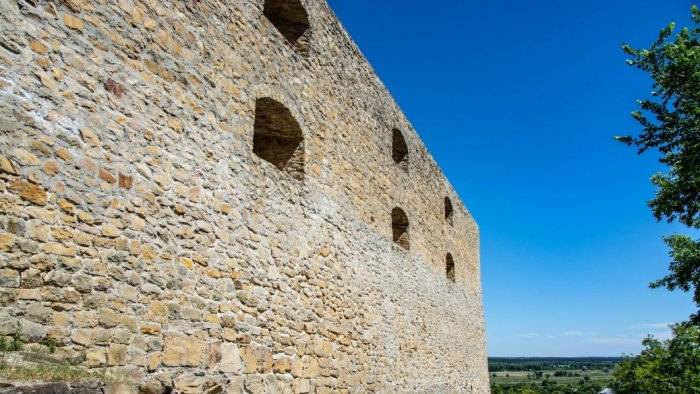Chigirin "was defended and lost, abandoned, but not taken"

Chigirinsky castle
Start of the 1678 campaign of the year
At the beginning of 1678, the Russian government made another attempt to conclude peace with Porte. The steward Afanasy Parasukov was sent to Constantinople. However, Russia's proposals for peace were rejected.
The Sultan insisted on his right to own Ukraine. He demanded to surrender Chigirin and other cities. Some Sultan's officials believed that peace could be made with Russia, since favorable opportunities opened up on the Middle Danube against Austria. But the grand vizier Kara-Mustafa wanted to take revenge for last year's defeat.
For the campaign against Ukraine, the grand vizier gathered a huge army.
It was larger than last year. Troops were collected from Syria, Egypt, Anatolia and the Balkan countries. The new Crimean Khan Murad-Girey this time led the main forces of the horde.
According to various estimates, 140-180 thousand people (including auxiliary units) were gathered under the banners of Kara-Mustafa. The artillery park consisted of more than 140 guns, including 50 heavy ones. The 4 cannons were so powerful that 32 pairs of oxen were dragging them. And 6 mortars fired 120-pound bombs.
The Turkish gunners were well trained and experienced. The Turkish army was assisted by French engineers, fortress siege and mine warfare specialists.
The fighting began by the Crimean Tatars and Cossacks of Yuri Khmelnitsky.
They have been disturbing the borders of Russian Ukraine since winter. Then they invaded the territory of the Pereyaslavl regiment. Several villages were plundered. Many prisoners were taken away.
The Cossacks this time resolutely took the side of Moscow. Serko continued his correspondence with Khmelnitsky until May 1678.
However, the Cossacks, descending the Dnieper, defeated a large Turkish transport caravan near Kazy-Kermen, which was transporting supplies for the vizier's army. The Cossacks captured several cannons and banners. Then the Cossacks went to the Bug to act behind enemy lines.

Grand Vizier of the Ottoman Empire Kara Mustafa Pasha
The Russian Army
Russia was also actively preparing for a new campaign.
Romodanovsky and Samoilovich proposed generally repeating the plan of the 1677 campaign: exhausting the enemy with the defense of Chigirin, then inflicting defeat.
In the spring and summer of 1678, extensive work was carried out to restore and strengthen Chigirin. The old buildings were restored, a system of external fortifications was erected. The garrison was increased to 13,5 thousand tsarist warriors and Cossacks. It was headed by the governor Ivan Rzhevsky, his assistant was Colonel Patrick Gordon, who arrived at the fortress with his dragoon regiment.
The "castle" ("upper city") was defended by 5,5 thousand soldiers and archers, the "lower city" - by 7 thousand of the order chieftain Zhivotovsky. They had brought in enough gunpowder, their supplies were in the shelves. But they delivered few bombs, only 500, hand grenades - 1200. The artillery was brought up to 86 cannons, but they brought mostly light weapons that were easy to carry. 4 of the largest cannons fired 14-pound cannonballs, 6 - 8-10 pound cannons.
There were almost no experienced artillerymen, the guns were served by soldiers. Zeroing in the guns (due to lack of ammunition) was prohibited. All this had the most negative effect on Chigirin's artillery during the siege: four Turkish shots were answered with one. And the shooting was extremely inaccurate.
Romodanovsky's army numbered about 50 thousand soldiers. Hetman Samoilovich had 25 thousand Cossacks. A significant garrison was located in Kiev, it was headed by Prince Golitsyn. Engineering work was carried out to strengthen the city's defenses.
In April 1678, a separate corps of Kosagov (about 10 thousand people) was sent to Ukraine to ensure the crossing of the main forces of the Russian army across the Dnieper. In May, Kosagov's corps crossed the Dnieper near Gorodishche, founded a fortified camp, maintaining contact with Chigirin and awaiting the approach of the main forces.
The steward Kozlov was sent to the Volga, who, together with Prince Cherkassky, was to organize a campaign of the Kalmyks and Astrakhan Tatars to Chigirin, or to strengthen the Sich.
True, the Russian command in Ukraine this time was tied hand and foot.
In the previous campaign, the king trusted his experienced military leaders. They had complete freedom of action. Now the entourage of Tsar Fyodor Alekseevich felt their strength, imagined themselves as generals and decided to "steer" the war.
Romodanovsky was given careful instructions. They were confused, contradictory. They offered not to rush into hostilities, to try to come to an agreement with the Grand Vizier, to settle the matter peacefully. It was indicated that it was impossible to surrender Chigirin, the army must quickly go to the fortress and get ahead of the enemy. But if you fail to get ahead, then destroy the fortress, and transfer the garrison to strengthen Kiev.
The Moscow command was also concerned about a significant increase in the army.
Samoilovich was ordered to mobilize a militia from townspeople and peasants, according to a warrior from 3-5 yards. It was decided to involve the Don Cossacks in the main army. Before their approach (together with Cherkassky's detachment) Romodanovsky was forbidden to engage in a decisive battle.
However, the mobilization of the militia only slowed down the army, they preferred to leave the warriors in the city garrisons. Detained the army and the supply problem. Ukraine was devastated by a long war. Samoilovich was unable to prepare supplies on time. The regiments of Romodanovsky and Samoilovich had to move slowly, with stops, wait and pull up the carts.
The Russian command refused to cross at the positions of the Kosagov detachment at the Maksimovsky monastery. This was due to the shortcomings of the road to Chigirin from this place for a large army and a convoy.
Kosagov first received instructions to take the ferry at Tyasmin (r. Tyasmin). Then he was ordered to take a position closer to Chigirin. This was a mistake, since the enemy sent a large detachment of Tatars to Tyasmin. The main forces of Romodanovsky moved to Buzhin.
On July 6-13, Russian troops crossed the Dnieper. Then Romodanovsky waited for the arrival of the elite cavalry of Prince Cherkassky and Kozlov. In June, the Kalmyks, Astrakhan Tatars and mountaineers were gathered on the Volga, in July through Chuguev and Kharkov they moved to the Dnieper. At the end of July, they united with the army of Romodanovsky and Samoilovich. About 4 thousand horsemen arrived.
Did it make sense to wait so long for a small detachment?
On July 30, the army marched towards Chigirin.

Chigirinskaya fortress
Siege of Chigirin
The Sultan's army in April 1678 was located at Isakchi, on the right bank of the Danube. Here she was joined by the detachments of the Wallachian and Moldavian rulers.
In early May, the Turks crossed the Danube, then the Bug, they were joined by several thousand Cossacks of Hetman Yuri. On the way to Chigirin, the Crimean horde joined the army of the vizier.
On July 8, the enemy was at Chigirin. On July 9, the vizier suggested that the garrison surrender the fortress, he was refused. The siege began. The Turks brought bundles of brushwood, straw, bags of wool in the wagon train. Hiding behind them from bullets, they began to dig trenches, put guns. The batteries thundered, the first killed and wounded appeared.
On the night of July 9-10, the garrison made a strong sortie, which grew into a whole battle. The Ottomans lost up to 800 fighters. On the 10th, the Turks began heavy shelling of the fortress. Sometimes in a day up to a thousand or more cannonballs and grenades were fired along Chigirin.
The enemy quickly and skillfully built trenches, batteries and mines. On July 28, the Turks reached the ditch and rampart by trenches. The cannons had punched several holes in the log walls. They caught fire several times, they were extinguished under fire.
A strong fire also started in the "lower city", most of the buildings burned down. In the evening, the Ottomans went on the attack, climbed a dilapidated shaft. But they were thrown away.
On July 29-30, the Ottomans blew up several mines. They shook
Clouds of earth and logs flew into the sky. Turkish infantry climbed into the gaps.
But the Russians fought fiercely. They were shooting. They guessed about the preparation of mines, new fortifications were prepared in advance behind the gaps. Soldiers, archers and Cossacks met the enemy with bullets and counterattacked.
The Ottomans, in turn, pulled the batteries closer and prepared new tunnels. On August 3, the Turks stormed the fortress three times.
The Russians managed to build field fortifications behind the breaches. And threw back the enemy. In another section, a mine blew up part of the wall, the Ottomans again rushed to the attack. After a two-hour battle, the assault was repulsed. The commander of the garrison, Rzhevsky, was killed by an enemy grenade.
The troops were led by Gordon. True, he was clearly out of place. He was a military engineer by profession, but completely lost the mine war. The Turks blew up mines wherever they wanted. Then he offered the commander-in-chief to bring all the infantry into the fortress, although there was no cover for her, no place to turn around. And the troops suffered excessive losses from shelling.
Battle of Tyasminsky Heights
It was an unpleasant surprise for the grand vizier that the Russian army was already next door on the Dnieper.
Kara-Mustafa did not know the number of Russians. He sent a 10-thousandth Crimean cavalry corps to eliminate the bridgehead on the right bank of the Dnieper. Dragoons of General Zmeev in a brutal control room threw the enemy back.
But the Ottomans had enough strength to fight on two fronts. Another 20 thousand Tatar horsemen and Janissaries of Kaplan Pasha were sent to the Dnieper. On July 13, the Tatars launched an offensive on the bridgehead at Buzhina. The enemy pounced on the left flank, crushed the dragoon Zmeev.
The situation was corrected by the commander of artillery, steward of the Pushkar order, Semyon Griboyedov. Field artillery was moved to the first line. She laid siege to the Janissaries and Tatars with canshot at point-blank range. The Russian cavalry regrouped and counterattacked. They were supported by other regiments. Tatars and Turks could not withstand the blow.
Romodanovsky noted:
And those military people were beaten, and many were captured in full, many of Tur's banners were worn ”.
On July 15, Kaplan Pasha again led his troops into the attack.
Reitars and Cossacks counterattacked the enemy. Defeated the enemy and drove away. The entire Russian army crossed the Dnieper. But Romodanovsky was bound by the tsarist order, he was waiting for the arrival of the detachment of Prince Cherkassky.
Meanwhile, Kaplan Pasha, seeing the futility of the attacks, went on the defensive. And he took up defense on the Tyasmine river between the Dnieper and Chigirin. The strongest position was Strelnikova Gora. For two weeks the Ottomans dug in well, put in batteries.
This delay will have the most negative impact on the further course of the battle.
After the arrival of the Cherkassky cavalry, the Russian army launched an offensive. It was decided to force Tyasmin at the Kuvechi ferry. On July 31, Russian advance detachments under the command of Prince Cherkassky and General Wulf defeated the enemy's advanced units and threw them back to the heights. The enemy counterattack was repulsed, the main forces of the Russian army reached the crossing.
However, it was dangerous to cross while the enemy was in a dominant position on the river. Therefore, they decided to first capture the Tyasminsky heights. For their assault, the best forces were put forward: the Moscow elective regiments of Shepelev and Krovkov, archers, several Cossack and soldier regiments.
On August 1, our troops launched an assault, but failed.
On August 3, the offensive was repeated with large forces.
On the right flank were the "elective" (guards) regiments of Shepelev and Krovkov (5-6 thousand), in the center - 9 rifle orders (over 5 thousand), on the left flank - Cossacks, even to the left - Belgorod and Sevsk regiments. The second line housed the noble cavalry (15 thousand), in the reserve of the Serpents (10 thousand infantry and cavalry). The main blow was delivered by the right wing.
The Ottomans met the attackers with a flurry of fire. They pushed towards carts filled with grenades with lit fuses. The soldiers, overcoming the resistance of the enemy, climbed the Strelnikov Mountain. But then the Turks counterattacked. Our troops wavered and retreated. About 500 soldiers were surrounded. They covered themselves with slingshots, fired back from rifles and two field guns. And we withstood several attacks. They were saved by the counterattack of their neighbors - the archers. Shepelev was wounded.
The Russian troops regrouped and, with the support of the reserve, again went to the assault.
The Ottomans repulsed the first blow, and General von der Nisin died. Then the Russians attacked again. And they achieved victory.
The Turks began to retreat, threw 28 guns. But they left in an orderly, organized manner.
The Russian cavalry, which rushed to catch up, was thrown back by fire. Then our artillery was brought up, the enemy was covered right during the crossing. The order broke, the enemy crowds rushed to the crossings. A crush began on the bridges. Our cavalry again swooped down on them, chopping off the fleeing ones.
Kaplan was afraid that the Russians would cross the river on the shoulders of the Turks and continue the carnage. He ordered to burn the bridges.
Our troops lost 1,5 thousand people during the assault on the heights.
The enemy is 500 people. But during the flight, the Turks had already lost several thousand people. Osman Pasha, one of the main commanders in the Turkish army, was wounded and captured.
The fall of the fortress
On August 4, 1678, the Russian army was stationed two versts from Chigirin. Romodanovsky did not dare to go to the fortress and give battle. The Ottomans retained a numerical advantage. And it was dangerous to attack the fortified positions of the enemy across the swampy river valley.
But there was no more complete blockade of the fortress. The enemy retreated from the left bank of the Tyasmin. It was possible to send reinforcements to Chigirin, bleed the enemy, force him to leave.
On August 4-5, reinforcements arrived at the fortress - the regiments of Jungman and Rossworm, then another 2 thousand soldiers and 800 archers. However, they showed low combat effectiveness.
Meanwhile, the vizier tried to put the squeeze on Chigirin. Cannons rumbled. The Ottomans blew up another section of the wall and went to storm, but they were thrown back. On the night of August 6-7, Kosagov tried to occupy the island downstream, but in the morning he was knocked out by the Ottomans. General Wolfe's troops settled on another island, from where they fired at the enemy camp, but without noticeable success. Meanwhile, the Sultan's army intensified the onslaught, blew up a few more mines, and brought down part of the fortifications. On August 7, the Turks captured part of the castle wall. At this time, another reinforcement came - Krovkov's guards. They attacked from the march and threw back the enemy.
The vizier held a council of war. Most of the commanders were in favor of lifting the siege. Kara-Mustafa became obstinate. We decided to go for another decisive assault. And if it doesn't work out, then leave. The cannons spoke again, the mines exploded. Gordon appealed to Romodanovsky, asked for new reinforcements. Romodanovsky decided to send a large detachment of Wolf (15 thousand) to the fortress, ordered a large sortie and destroy the enemy positions at Chigirin.
The bridge across Tyasmin was destroyed. And the reinforcements were only able to be transported on the 10th. The sortie with fresh forces was unsuccessful. Gordon did not support her with his shelves -
And the Turks noticed the arrival of Russian regiments, stopped them with artillery fire and counterattacks.
On August 11, the Ottomans detonated two more mines, made a large breach and launched an assault. Confusion reigned among the various Russian units packed into the fortress. They did not immediately counterattack the enemy.
Janissaries burst into the "lower city".
At this time, fresh forces arrived, two soldiers and two Cossack regiments. They drove the enemy back.
Having regrouped their forces, the Turks went on the offensive again. The city was on fire. There was a rumor among the defenders that the city had fallen, and panic began. Some still fought, beat the Turks, others fled to the castle or to the bridge. On the broken bridge, many fell into the water and died. The Ottomans pressed against the bridge and killed several hundred Cossacks and soldiers. Gordon lost control. Romodanovsky tried to send new reinforcements, the archers and Cossacks made their way to the fortress, but a strong fire had already spread there. Defending the blazing ruins has become meaningless.
At night, Romodanovsky ordered Gordon to destroy the castle and leave. The defenders left along the dam. They left undefeated, with banners, took away the treasury, light cannons.
The garrison successfully linked up with the main forces. Gordon was one of the last to leave the fortress and set fire to the powder magazine. From a powerful explosion, in his opinion, several thousand Turks died, who had already broken into the castle.
According to Gordon, Chigirin
There was a threat that the Sultan's army would march on Kiev.
Therefore, it was necessary to return across the Dnieper, to defend the Left Bank, to connect with the reinforcements on the way.
On August 12, 1678, the Russian army, having built up in a huge square and covered with carts, began to retreat to the Dnieper. The best units were in the rearguard - the regiments of Shepelev, Krovkov, Wulf and Streltsy.
The vizier ordered to raise the troops, follow the enemy, press them against the Dnieper and crush them. That would be a victory! All of Ukraine would remain defenseless.
The Tatars and Turks of Kaplan Pasha made several attacks against the rearguard and flanks of the Russian army, but without success. On August 13, the Russians reached the fortified camp near the Dnieper. The Turks occupied the commanding heights (a mistake of the Russian command) and began shelling our camp.
Gordon recalled:
Crossing in such conditions was suicidal.
On August 14-19, Russian troops attacked enemy positions several times, the battles went on with varying success.
At this time, additional mobilization was carried out in the border cities, troops were being prepared to go to the rescue of Romodanovsky's army.
On August 21, the Turks left their positions on the Dnieper, on the 23rd they destroyed the remains of the Chigirin fortress and went to the Danube. Khmelnitsky's detachment destroyed Kanev, captured Nemyriv and Korsun. By August 27, Russian troops returned across the Dnieper.
Turkish and Russian losses in this campaign are unknown.
There is an assumption that the Ottomans lost from 30 to 60 thousand people (heavy losses were one of the reasons for the refusal of the further war for Ukraine). Romodanovsky's army - about 9 thousand people. Chigirin's garrison - 2,5-3 thousand people.
Ending war
The fall of Chigirin actually decided the outcome of the war.
Porta restored its power in the Right-Bank Ukraine.
Chigirin was not restored. Turkish hetman Yuri Khmelnitsky was imprisoned in Nemyriv. True, the Ottomans did not receive a large profit from that possession.
Most of the population of the Right-Bank Ukraine fled to the left bank of the Dnieper, or was driven into slavery. Almost all towns and villages were burnt and ruined.
Khmelnitsky with the Tatars in the winter attacked the Left Bank, captured several villages and forced their inhabitants to cross to the right bank. But he did not achieve great success.
Samoilovich and Kosagov organized a retaliatory raid and drove away the enemy. Then Samoilovich's Cossacks went to the right bank and took the residents of Rzhishchev, Kanev, Korsun, Cherkas and other villages to the Left Bank.
The Russian government ordered the governors not to go to the right bank, to confine themselves to the defense of the Left Bank.
After the resignation of Romodanovsky, who led the Russian troops in Ukraine for 23 years (with short interruptions), he was recalled to the royal court. The Belgorod category was headed by the boyar Ivan Miloslavsky (the cousin of the queen). Prince Cherkassky was appointed commander-in-chief.
The Russian command expected that the Ottomans in 1679 would continue the war and go to Kiev. The city was fortified, built around several castles, built bridges across the Dnieper, providing a quick ferry of reinforcements. In 1680, the Russians continued to hold large forces in the Ukrainian direction. But taking into account the reduction of the threat, their number has been reduced.
However, the sultan and the grand vizier abandoned plans for further conquests in Ukraine.
The victory at Chigirin was given with a lot of blood. The Russian army was intact and ready for further battles. The fighting spirit and military qualities of the Russians made a great impression on the Sultan Pasha. An attempt to take Kiev and break through to the left bank could cost even more. The Turks had information about the large-scale preparation of the Russians for the defense of Kiev and the mobilization of their army.
The conquest of the Right Bank, completely devastated, did not justify itself.
The seizures in Austria seemed more profitable. Therefore, the Turks limited themselves to the construction of fortresses in the lower reaches of the Dnieper in order to close the way to the Black Sea for the Cossacks.
At the same time, peace negotiations began.
Moscow sent the steward Daudov to Constantinople in the spring of 1679. Almost at the same time, the Sultan instructed the Moldovan ruler I. Duque to mediate with Russia to conclude peace.
Captain Billevich arrived in Moscow in May. In the fall of 1679, Daudov returned to Moscow with a letter from the vizier, in which it was proposed to send an ambassador to Bakhchisarai to conduct peace negotiations. An embassy of Sukhotin was sent to Crimea, which had the authority to conclude peace. In the summer, Sukhotin was replaced by the steward Tyapkin.
On January 3 (13), 1681, the Treaty of Bakhchisarai was signed.
The border was established along the Dnieper. On the right bank, Russia retained Kiev and its surroundings. The left bank was recognized for Moscow. Zaporozhye remained formally independent. The Cossacks received the right to free movement along the Dnieper and its tributaries to the sea.
The Crimean Khan received a "commemoration" from Moscow.
In 1682 the treaty was confirmed in Constantinople.
Turkey started a war against Austria. She was not up to Ukraine.
- Alexander Samsonov
- https://ru.wikipedia.org/, https://runivers.ru/

Information